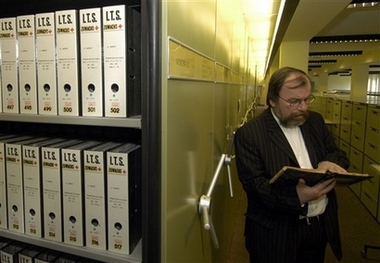Opening of Nazi Archive moving forward
(AP)Updated: 2007-05-14 08:43
AMSTERDAM, Netherlands - As the Third Reich headed to defeat in World War II, the Germans burned millions of records to cover up history's worst genocide. But the fraction that survived was enough to make up the largest Nazi archive in existence.
 Udo Jost, archive manager, views papers at the International Tracing Service in Bad Arolsen, Germany, April 19, 2006. [AP]  |
The 11-nation commission governing the International Tracing Service, an arm of the International Committee of the Red Cross, meets in Amsterdam Monday and Tuesday to decide when and how to make electronic copies of its files available to researchers.
So far the archive of 30 million to 50 million pages in Bad Arolsen, Germany, has been used only to help reunite families and verify restitution claims. The files were closed in 1955 because it was feared that unfettered access could violate the privacy of Holocaust victims, both living and dead.
But survivors have been pressing for direct access, unsatisfied with the formalistic and partial answers to questions about the persecution they suffered. So a year ago the commission decided to unlock the vast storehouse for research.
As the survivor generation dwindles, the decision to digitally scan the documents and make them available will shift the archive's primary function from a humanitarian service to a historical resource.
"We have been living in splendid isolation all these years. Now we have been told we must be part of the system," said the archive's director, Reto Meister.
"If we can network, our worth multiplies," Meister, a former Swiss diplomat, said in a recent interview. "You have to share your wealth."
The Associated Press has visited the archive four times since October and has written extensively about its contents on condition that the identities of victims are protected.
But the overall opening-up has taken longer than expected. All 11 governments have to ratify the decision. The United States, Israel, Poland, Britain, the Netherlands, Germany and Belgium have completed the process. Luxembourg, Greece, Italy and France have yet to endorse it.
The US delegation says it will press the meeting on Monday to allow scanned material to be distributed immediately, even before ratification is finished.
"Everyone's expectation is the vote to distribute the stuff will sail through," said delegate Paul Shapiro, director of the Center for Advanced Holocaust Studies at the US Holocaust Memorial Museum.
Shapiro said once the raw material is in hand, it will take several months to prepare it for academic use. By that time, the legalities might be complete.
The collection takes up 16 linear miles of space filling six buildings. By the end of next month some two-thirds of it will be ready for transfer to authorized national institutions in the 11 countries, Meister said.
The Nazis destroyed 90 percent of their files, said Dieter Pohl, of the Institute for Contemporary History in Munich. The office headed by Adolf Eichmann, who orchestrated the transport of millions of Jews to the gas chambers, began burning its records in February 1945, nearly three months before Germany surrendered.
Eichmann's office had 3,500 employees working over six years, Pohl said. "Imagine the number of files it had."
Among the documents that survived are millions of pages of death registers, concentration camp records, transport lists, and internal Nazi communications, such as Gestapo chief Heinrich Himmler's command to evacuate the concentration camps before they were captured.
"No prisoner must be allowed to fall into the hands of the enemy alive," it said.
The last files to be prepared will be postwar records from displaced persons camps - hundreds of thousands of envelopes containing applications for immigration visas by people whose homes and families were consumed in the Holocaust.
Three out of four envelopes have never been opened since they were first processed, said Bad Arolsen archivist Rudolf Michalke.
Over the decades, the Tracing Service has responded to some 11 million inquiries from survivors or families, but it has rarely allowed anyone to view the actual records. However, the US National Archive and Israel's Yad Vashem Holocaust memorial were allowed to copy some of them in the early 1950s.
|
||
|
||
|
|